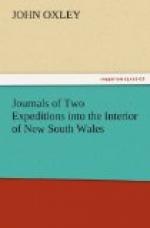a small stream taking its course to the sea.
To the north and south the country was mountainous
and broken beyond any thing we had seen. Indeed,
some idea of those barrier mountains may be formed
from the circumstance, that although we could distinctly
see the ocean, and the waving of the coast line, (which
within the distance of ten or twelve miles from the
beach appeared low), yet we were still nearly fifty
miles from it. I estimated the height of this
mountain at between six and seven thousand feet; and
yet the country north and south appeared equally elevated.
Numerous smokes arising from natives’ fires
announced a country well inhabited, and gave the whole
picture a cheerful aspect, which reflected itself on
our minds; and we returned to the tents with lighter
hearts and better prospects. In removing the
baggage left at the bottom of the hill a short quarter
of a mile, a most distressing accident occurred.
A mare, one of the strongest we had, in bringing up
a very light load, not a quarter of her usual burden,
and when within one hundred yards of the tent, literally
burst with the violent exertion which the ascent required.
In this shocking state, with her entrails on the ground,
she arrived at the tent, when, to put an end to her
agonies, she was shot. This was a serious loss
to us, in addition to that which we suffered on the
day before: and three more horses were so worn,
that I scarcely expected to force them along even
unladen. It must not be supposed that we attempted
to climb these hills in a direct line; it would have
been scarcely possible for a man to do it: we
wound round them in every practicable direction; and
the loose rich soil of which they were generally composed,
together with the thickness of the timber, by preventing
our falling, favoured our progress. In the course
of the afternoon I tried the angle of elevation and
depression on various parts, and found it to be from
30 to 35 and even 40 degrees. By the same means
we found that the mountain which we had descended
yesterday evening exceeded four thousand seven hundred
feet in height on those angles. The mountain
we shall have to ascend to-morrow is very considerably
higher; but, with one or two exceptions, the ascents
are not so abrupt. After the provisions were brought
up, all hands were sent to cut a road for the horses
through the brushes which surrounded the bottoms of
the steepest ascents, and without which it would have
been impossible for them to pass laden; the vines
which crossed each other in various directions forming
an almost impenetrable barrier. It may seem superfluous
to speak of soil and timber among such mountains as
these; yet I will say that except where the rocks
presented a perpendicular face, and along the highest
ridges, the soil was light and good. The timber
consisted of blue gum and stringy bark, and forest
oak [Note: Casuarina torulosa.] of the largest
dimensions: the gorges of the valleys were covered
with loose small stones, and in those gorges all the




